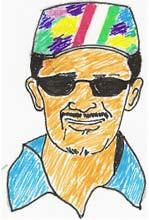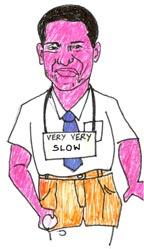There is a buzz in the warm Bangalore air at the Chinnaswamy stadium as I make my way towards the newly-built office of the 'Centre for Radical Ideas and Enterprising Solutions' (CRIES). A bold new initiative of the BCCI, CRIES has not received much media attention and has sought to maintain a low profile since its inception.
A brainchild of Greg Chappell, my minimally reliable sources tell me that it was one of the main selling points that he used in his job interview with the BCCI, staving off stiff local competition from tricolour wielding, computer-illiterate contenders. If all of Mr. Chappell's good intentions were to bear fruit, CRIES will facilitate every manner of creative and innovative approach to making the present Indian team go from simply average to almost superhuman.
The de Bono thinking method is a case in point. Pioneered by Edward de Bono, this radical analytical technique was recently imparted to trainees at the national coaching camp. The de Bono sessions were so popular with the current Indian team that unconfirmed reports indicate some of the senior players refused to part with their hand-crafted, coloured thinking caps. Scribes and the local paparazzi are keeping the oculars peeled for Anil Kumble in a multi-hued cap that says 'bold and beautiful.'
 I was here to bear witness to yet another inspired technique that has caught the Indian coach's fancy. One week before his wards flew out to Colombo for the triangular one-day series, Greg Chappell enlisted the services of Harish Podhar, the reigning king of India's burgeoning business process outsourcing (BPO) boom.
I was here to bear witness to yet another inspired technique that has caught the Indian coach's fancy. One week before his wards flew out to Colombo for the triangular one-day series, Greg Chappell enlisted the services of Harish Podhar, the reigning king of India's burgeoning business process outsourcing (BPO) boom.
Harish is renowned for his novel coaching techniques that are fast becoming the accepted norm for every aspiring call-centre employee. From anglicised Indian names to accent-retraining and personality transplants, the Podhar stable tends to every little detail vital to the survival of the country's latest cottage industry.
Dressed in a spotless white kurta-pyjama, Harish greets me with a sing-song, "Hi, I am Harish and I am here to help you." I realise with a tingle that this is perhaps the original voice and tone that spawned a thousand call-centres, the very same intonation that greets every unsuspecting denizen of the world dialling a 1-800 telephone number. He adds helpfully, "Feel free to call me Hari, although the BCCI files have me down as Harry Potter."
The particular brand of expertise Harish shared with the Indian cricket team over the next few days was the 'hum donon' protocol. The method identifies pairs of team members with particular shared concerns or "client requirements" as Harish prefers to call them and encourages each pair to explore the issue of interest in some depth.
"This allows every player in the team to create an environment with a team-mate that is supportive, friendly and conducive to problem solving," explains Harish, with the confidence of one who has presided over numerous happy hum donon endings. After Greg Chappell's enthusiastic endorsement of the method, the current Indian team is getting its first close look at the technique.
My first stop is at the 'Milky way' module. I enter a cosy auditorium inside which Virender Sehwag and MS Dhoni are seated opposite a giant television screen. Harish whispers to me that he has identified the development of 'mental toughness' and 'nutrition' as shared concerns for this pair, perhaps India's newest opening partnership in one-dayers. The lights dim and as the screen comes to life, the video plays a crisp recording of Kapil Dev foaming at the mouth, gesticulating animatedly and launching into a heartfelt tirade on the singularly inspirational qualities of "ma-ka-dhoodh."
Sehwag looks somewhat glazed and Dhoni a trifle taken aback, but Harish is wearing the satisfied look of a man who understands that he has just unleashed an awesome power.
"Imagine how Viru will now react to Flintoff's sledging," he says. "Kapil-paaji's words will continue to ring in his ears, goading him to blast Freddie out of the ground."
Before I can voice even a hint of well-meaning skepticism, the video clip changes to one of cows. Dozens of them march along a verdant pasture contentedly, as a lilting Hariprasad Chaurasia tune plays in the background. A ticker floats across the bottom half of the screen proudly proclaiming that this particular segment, "gaai-ka-dhoodh,' is sponsored by Amul, Indian cricket's "utterly-butterly-friend-in-need."
A voice-over then proceeds to explain all the goodness that Mother Nature has distilled into the beverage and the particular benefits of downing it in copious volumes prior to any onerous task. I spy Dhoni taking notes furiously and as the lights come on, Harish wears an almost bovine look of contentment.
 My next port of call is the SWAT team- the 'Special Worries and Tactics' unit. Harish explains that this is a module where the primary concerns of the pair relate to matters that are essentially of a non-cricketing nature. I am led into a large complex simply called 'The Courts.' A worried Sourav Ganguly is poring over a voluminous legal tome in fine print titled, 'Loopholes and Last Resorts.'
My next port of call is the SWAT team- the 'Special Worries and Tactics' unit. Harish explains that this is a module where the primary concerns of the pair relate to matters that are essentially of a non-cricketing nature. I am led into a large complex simply called 'The Courts.' A worried Sourav Ganguly is poring over a voluminous legal tome in fine print titled, 'Loopholes and Last Resorts.'
A team of legal eagles in white horsehair wigs is hunched over a table going over every piece of ICC legislation and at random intervals, cries of "I found another" rent the air, as Sourav's textbook is updated continuously.
Adjoining this legal beehive is an indoor tennis court where Sachin Tendulkar is at the receiving end of some meticulous medical attention. Two gents in green scrubs watch a slightly bemused Sachin execute a variety of imaginary ground strokes with a tennis racquet. After each forehand or overhead, a motley assortment of instruments emerges from their cavernous pockets to make detailed measurements of Sachin's limbs and accessible appendages.
Harish senses my growing bewilderment and hastens to explain that the medics are two of India's finest orthopaedic surgeons. "One for each elbow," he gushes, anticipating my question. "Although they know all there is to know of elbows, I sensed that their knowledge base of tennis needed improvement. So what better way of getting to the very heart of Sachin's problem than to see him actually playing tennis," Harish adds with an air of finality.
I am warned that the next stop on this fascinating tour is not one for the faint of heart. It is ominously called the 'Hall of Shame.' Harish whispers conspiratorially to me that there comes a time in every cricketer's career when even the most gifted cricket-writers are unable to offer remedial advice. This happens but rarely, and when verbose and seasoned ESPN commentators can no longer dissect, analyse and tear down a technical problem to its tortuous essentials, it is time for drastic measures.
I enter a dimly lit room with a single overhead bulb and a chair. It resembles a classroom and I can make out the silhouette of a tall figure pacing the length of the room, while his colleague is seated and stares blankly at the blackboard. As my eyes adjust to the dim light, I recognise Irfan Pathan and VVS Laxman in school uniforms - pleated khaki shorts, white shirts and navy blue ties.
Irfan, who is doing all the nervous to and fro-ing, has a sign around his neck that says, 'The dog ate my inswinger' while Laxman, looking similarly forlorn, holds a card with the words, 'Very Very Slow' on it. As I struggle to come to grips with the sight, my ever-helpful guide issues a note of clarification, "they both need time to think about what they have done, and what they are no longer doing, so that they can help each other do what we all know they should be doing." My rapidly tiring nervous system tries to wrestle with this seemingly obvious logic as we exit the room.
Just as I begin to wonder if the hum donon experience is all work and no play, I am led into an opulently furnished suite of rooms, where I see Rahul Dravid seated cross-legged on the floor, in the lotus pose, peering intently into a daunting book. It is Sun Tzu's 'Art of War' and Rahul-The-Wall-Dravid is devouring it in the original 4th century Chinese.
As Indian cricket's newly crowned king educates himself in the ancient oriental secrets of battle, I glance upon Bhajji sprawled on the couch and sound asleep. As his snores emerge in incrementally contented octaves, I crane my neck to take a look at the book beside him - 'How to drive a bus in 30 days.' It is all part of the grand scheme to make our cricketers complete personalities Harish explains, "Think of this as a finishing school- when they are done here, we make sure they are finished."
Illustrations: Mohankumar Choyi





